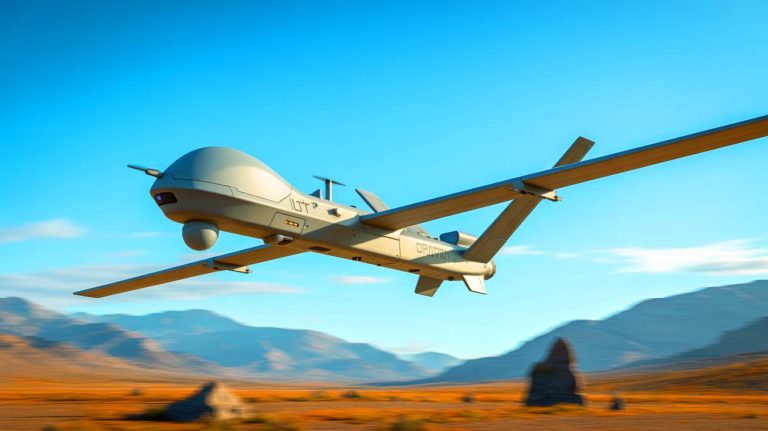| IN A NUTSHELL |
|
In an era where technological advancements continually reshape the landscape of warfare, the introduction of the Red Dragon drone by AeroVironment marks a significant shift in military capabilities. This new system reflects the growing reliance on unmanned aerial vehicles (UAVs) for offensive operations, representing a leap forward in the realm of autonomous weaponry. As the demand for such technologies increases, so does the need for ethical considerations and strategic adaptations, forcing military forces worldwide to rethink their approaches to warfare. How will the Red Dragon and similar technologies change the future of combat?
Red Dragon: A New Suicide Drone
The Red Dragon drone is a cutting-edge addition to the rapidly evolving field of military UAVs. Although part of a new generation of attack drones, it leverages existing technologies to maximize its effectiveness. Central to its design is AeroVironment’s AVACORE software architecture, which works in tandem with the SPOTR-Edge perception system for precise target detection. Additionally, the DDIL radio system facilitates seamless communication between the drone and its operator, ensuring operational efficiency.
Designed for quick deployment and tactical flexibility, Red Dragon can be launched by small infantry battalions from virtually any location. Its versatility allows it to strike targets in the air, at sea, or on land. With a cruising speed of up to 63 mph and the ability to accelerate to 100 mph, this drone is built for speed. Its longest-range configuration covers up to 248 miles, and it can carry a 22-pound payload, making it a formidable tool on the battlefield.
A Step Forward in ‘Autonomous Lethality’
AeroVironment touts the Red Dragon as a significant advancement in autonomous lethality. The drone’s design allows for rapid deployment, with a specialized launching system capable of launching five drones per minute. Its stealthy operation is enhanced by its quiet nature, enabling surprise attacks even in GPS-denied and communications-degraded environments.
While the exact deployment date of Red Dragon on real-world battlefields remains unannounced, its potential for mass producibility suggests that it could soon become a staple in modern military arsenals. As the first in a new line of systems, the Red Dragon heralds the arrival of more advanced autonomous drones, promising to transform the way military operations are conducted in the near future.
The Rise of Drone Warfare
The rise of drone warfare presents both opportunities and challenges for military forces worldwide. As these technologies become more prevalent, traditional concepts of air superiority and battlefield engagement are being redefined. The US Marine Corps’ recent deployment of a prototype handheld counter-drone system underscores the urgency of adapting to this new threat.
The moral implications of autonomous drone technologies further complicate the issue. These systems allow for target selection and engagement with minimal human intervention, raising ethical concerns about the delegation of life-and-death decisions to machines. Despite assurances from the U.S. military to maintain human oversight in critical decisions, the potential for other actors to bypass these safeguards remains a significant concern.
Ethical and Strategic Implications
The introduction of drones like the Red Dragon forces a reevaluation of ethical standards in warfare. The ability of these systems to operate with limited human involvement challenges traditional notions of accountability and responsibility in combat scenarios. As such technologies proliferate, the need for comprehensive ethical guidelines becomes increasingly urgent.
Strategically, the adoption of advanced UAVs necessitates new training protocols and defense strategies. Military organizations must not only integrate these technologies into their operations but also prepare for the potential threats posed by similar systems employed by adversaries. The balance between leveraging technological advantages and maintaining ethical standards will be crucial in shaping the future of warfare.
As the Red Dragon and its successors continue to evolve, they will undoubtedly influence military tactics and ethical debates worldwide. With the potential to revolutionize combat operations, these drones prompt a critical question: How will nations balance the pursuit of technological superiority with the need for ethical accountability in warfare?
Did you like it? 4.6/5 (24)











Wow, 100 mph? This drone probably moves faster than my internet connection! 🚀😂
Is there a risk these drones could be hacked and turned against their own forces?
Thanks for the informative article. The ethical implications are definitely concerning.
Why are these called “suicide drones”? Seems like a harsh term. 🤔
Are there any international laws regulating the use of such lethal autonomous weapons?
This tech is impressive, but it really feels like we’re moving towards a sci-fi dystopia.
How well can these drones operate in bad weather conditions?
Great article! But I’m curious about the cost of deploying such advanced drones.